

Flora Capture: a citizen science application for collecting structured plant observations. Architectural overview We designed the Flora Capture system as a flexible client–server solution consisting of scalable micro services running in our data center and client applications realizing different plant identification scenarios (see Fig. 2).
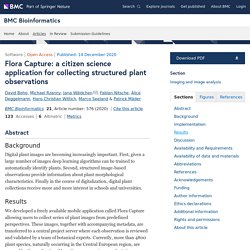
Below, we briefly describe the system’s modules. Architectural overview of the Flora Capture system Flora Capture app The Flora Capture app is a multi-platform app, freely available on Android and iOS with a modular code base ensuring maximum reuse and consistency of functionality across the different applications developed within the project. Flora Capture enables users to take offline multi-image observations that are identified batch-wise upon sync to our server and allow for creating a digital plant collection. Q&A Document - After the crowds disperse: crowdsourced data rediscovered and researched. Workshop invitation: After the crowds disperse: crowdsourced data rediscovered and researched. ***Deadline for expressions of interest extended to 30th October 17:00 UTC.*** You put your images in, your data come out – that’s what crowdsourcing’s all about!

It sounds simple but there are many hurdles to cross after a citizen research project comes to an end. Express your interest to join us at an online workshop exploring the crowdsourced data cycle in cultural heritage organisations hosted by Royal Botanic Garden Edinburgh. Join us on the first in a series of virtual expeditions of Britain and Ireland. The collections from Britain and Ireland held within the RBGE Herbarium are estimated to number over 500,000 specimens of cryptogams (algae, fungi, lichens and mosses), ferns, gymnosperms and flowering plants.
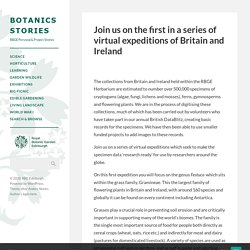
We are in the process of digitising these collections, much of which has been carried out by volunteers who have taken part in our annual British DataBlitz, creating basic records for the specimens. We have then been able to use smaller funded projects to add images to these records. Join us on a series of virtual expeditions which seek to make the specimen data ‘research ready’ for use by researchers around the globe. iNaturalist and Crowdsourcing Natural History. The citizen-science database iNaturalist is closing in on 49 million observations.
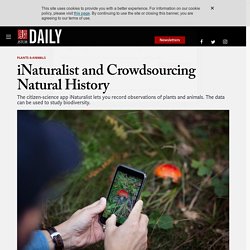
This app-based initiative of the California Academy of Sciences and National Geographic allows anyone with an internet connection to upload location-coded images and sounds of plants and animals. If the observer doesn’t know what they’re looking at, other participants or the app’s artificial intelligence ID function may be able to help. Begun as a master’s-degree project of three students at the University of California, Berkeley’s School of Information in 2008, iNaturalist has become one of the most popular nature apps ever. Over a million and a quarter people are now participating. So what is all this data good for? Bowles’s case study is the Japanese burrowing cricket (Velarifictorus micado), first spotted in the U.S. in 1959 in the District of Columbia; its true source is unknown, he writes, although introduction via “discarded or escaped fishing bait or via ornamental plants” is possible.
Finding new species on social media. Most people’s idea of discovering a new plant species for science is a botanist rounding a corner in a remote part of the world and spotting an unusual flower they have never seen before.
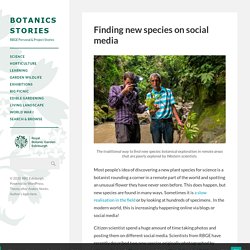
This does happen, but new species are found in many ways. Sometimes it is a slow realisation in the field or by looking at hundreds of specimens . In the modern world, this is increasingly happening online via blogs or social media! Citizen scientist spend a huge amount of time taking photos and posting them on different social media. The ReCAP: Stories from California Herbaria. While many herbarium collections across the state are sitting in silence, their curators, data managers, technicians, and volunteers are doing quite the opposite.

Herbarium databases are a flurry of activity as faculty, staff, and citizen scientists take advantage of the past years of digitization efforts to create and expand herbarium specimen data. Thousands of the >560,000 specimens imaged by the California Phenology Network since January 2019 still need to have their label data entered in the database. Mahalo to Bev and all our fantastic #volunteers who help the #Garden in so many ways.□ #herbarium □ #volunteer #saveplants □ Plantentuin Meise op zoek naar "mensen met veel tijd"
Connecting Students to Citizen Science and Curated Collections. Interconnect: A double collaboration. Expanding the value of herbarium specimens with citizen science app, iNaturalist - Carnegie Museum of Natural History. An exciting opportunity to volunteer at the UK's oldest botanic garden in our new Herbarium Room, a ‘mini museum’ to showcase the Garden’s near 400 year-old relationship with Oxford’s world-class Herbaria. Application deadline 19th May. Policy Perspectives on Citizen Science and Crowdsourcing. Auerbach, J, Barthelmess, EL, Cavalier, D, Cooper, CB, Fenyk, H, Haklay, M, Hulbert, JM, Kyba, CCM, Larson, LR, Lewandowski, E and Shanley, LA. 2019.
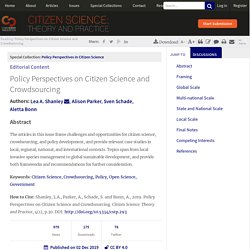
The Problem with delineating Narrow Criteria for Citizen Science. PNAS, 116(31): 15336–15337. DOI: Bastian, A and Byrne, M. 2012. The National Broadband Map: A Case Study on Open Innovation for National Policy. Washington, DC: Woodrow Wilson International Center for Scholars. Today we have opened up the Angela Marmont Centre for @NHM_London staff to show all the work we are doing with #citizenscience, UK biodiversity monitoring & more!
Four days, 32 volunteers, and nearly 120 jars later, this years Community Curators has drawn to a close. I’m so grateful for all the amazing participants involved in this bit of #CitizenScience! Natural sciences students helping us catalogue our diatoms using @the_zooniverse. Have a go - @McrMuseum. Thanks to our newly trained volunteers @SirJosephBanks Centre for mounting these excellent #Herbarium specimens for our contemporary collection. Amazing to see Cornflower (Centaurea cyanus) living up to its name, retaining its vibrant cyan colour post dry. Notes from Nature - WeDigFLPlants. Citizen Science and Climate Change: Mapping the Range Expansions of Native and Exotic Plants with the Mobile App Leafsnap. Skip to Main Content Sign In Register Close Advanced Search Online ISSN 1525-3244 Print ISSN 0006-3568 Copyright © 2018 American Institute of Biological Sciences Connect Resources Explore Oxford University Press is a department of the University of Oxford.
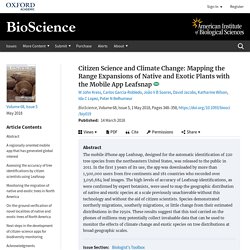
Close. Citizen Scientist. Public engagement in scientific research (sometimes referred to as citizen science) is not new, but new web resources (e.g., from the Zooniverse, Cornell Lab of Ornithology, and USA National Phenology Network suites of projects) provide scientists with opportunities to engage the public in ways and at scales not previously possible.
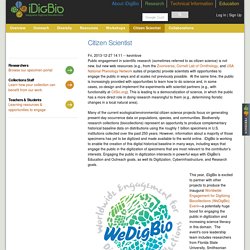
At the same time, the public is increasingly provided with opportunities to learn how to do science and, in some cases, co-design and implement the experiments with scientist partners (e.g., with functionality at CitSci.org). This is leading to a democratization of science, in which the public has a more direct role in doing research meaningful to them (e.g., determining floristic changes in a local natural area). Many of the current ecological/environmental citizen science projects focus on generating present-day occurrence data on populations, species, and communities.
The WeDigBio event is just one of several Citizen Science-related iDigBio activities. What better way to mark #MuseumWeek than to celebrate the fantastic progress of the #VFactor team @NHM_Botany Using the curatorial skills they have learned over the past 7 weeks, they have prepared 82 shelves of specimens for digitisation. That is c. 3000. Putting the ‘I’ in science. The Crowd and the Cosmos: Adventures in the Zooniverse Chris Lintott Oxford University Press (2019) Citizen science is booming.

You're invited! Join us and @WeDigBio from 10am-4:30pm next Friday (10/18) to transcribe and re-house our historic seed collection! Using Crowd-curation to Improve Taxon Annotations on the Wikimedia Infrastructure. Citizen Science: Leaf Survey. A massive thank-you to the fantastic @NHM_Botany V factor volunteers who are finishing up their project today. Over the past 10 weeks they have cleaned, annotated and prepared 40,000 specimens from the cotton family for digitisation. #VolunteersWeek2019 #
Portals. Results. Encountering the Unexpected. A Scientific Look at Citizen Science. Citizen science needs to look more like society, report says. Scientists who team up with the public to conduct research need to do a better job of including all segments of society. That’s one of the key recommendations in a new report on citizen science by the U.S.
National Academies of Sciences, Engineering, and Medicine in Washington, D.C. HIstory of Citizen Science. Citizen Science Takes Root » American Scientist. Building on a long tradition, amateur naturalists are gathering data for understanding both seasonal events and the effects of climate change. Kayri Havens, Sandra Henderson In the mid-1800s, Henry David Thoreau sojourned outside Concord, Massachusetts, immersing himself in the world around him. He planted beans, entertained visitors, repaired to his mother’s house in Concord for hearty meals, and wrote Walden; or, Life in the Woods. Less widely read are the copious observations and measurements he made around the same time, between 1851 and 1858, of plants and animals at Walden Pond.
But more than a century later, his records are drawing attention in their own right among ecologists seeking a view into past climates. Thoreau was especially interested in the initial leafing and flowering of plants in springtime. #CitizenScience. Skip to Main Content Sign In Register Close Advanced Search Online ISSN 1525-3244 Print ISSN 0006-3568 Copyright © 2018 American Institute of Biological Sciences.
Phenology and Citizen Science. Crowdsourced transcription. Article Citation: Lesley Parilla and Meghan Ferriter (2016) Social Media and Crowdsourced Transcription of Historical Materials at the Smithsonian Institution: Methods for Strengthening Community Engagement and Its Tie to Transcription Output. Science Products Inventory for Citizen-Science Planning and Evaluation. Skip to Main Content Sign In Register Close Advanced Search. Tips for digital participation, engagement and crowdsourcing in museums. I was asked to share some of the lessons I’ve learnt from building digital participation projects in museums and from my research on crowdsourcing in cultural heritage for the London Museums Group blog following my talk at their “Museums and Social Media” event on 24 May at Tate Britain.
Herding the fuzzy bits: What do you do after crowdsourcing? Twitter Conversations as Embryonic Citizen Science Communities. Abstract. Book: Searching for Heroes and Hope in an Age of Extinction. How citizen science could change historical research. Citizen science is a digital method, which has been applied to a range of big-data scientific problems. Citizen Science/class - iDigBio. Citizen science involves the public in the generation of scientific knowledge. BIOSPEX—A Crowdsourcing Management System. Biospex. NYBG: Herbarium Stewards Club (Bronx, NY) NYBG’s Citizen Scientists Document the Botanical History of the Northeast Online. Posted in Interesting Plant Stories on August 25, 2017 by Charles Zimmerman.
What Makes a Citizen Science Project Successful? The Impact of Coordinated Social Media Campaigns on Online Citizen Science Engagement. Smithsonian staff members recently presented a poster at the American Association for the Advancement of Science (AAAS) Annual Meeting in Washington, DC, 11-15 February, 2016. Open Science and Innovation: Of the People, By the People, For the People. Only a small fraction of Americans are formally trained as “scientists.” But that doesn’t mean that only a small fraction of Americans can participate in scientific discovery and innovation. Biodiversity Heritage Library - Purposeful Gaming. Smorball and Beanstalk: Games that aren’t just fun to play but help science too. Citizen Science Uses Art to Unlock Scientific Knowledge.